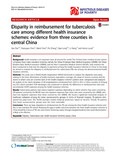| dc.contributor.author | Pan, Yao | |
| dc.contributor.author | Shanquan, Chen | |
| dc.contributor.author | Chen, Manli | |
| dc.contributor.author | Zhang, Pei | |
| dc.contributor.author | Long, Qian | |
| dc.contributor.author | Xiang, Li | |
| dc.contributor.author | Lucas, Henry | |
| dc.coverage.spatial | China | en |
| dc.date.accessioned | 2017-04-06T10:33:27Z | |
| dc.date.available | 2017-04-06T10:33:27Z | |
| dc.date.issued | 2017-01-27 | |
| dc.identifier.citation | Pan, Y., Chen, S., Chen, M., Zhang, P., Long, Q., Xiang, L. and Lucas, H. (2016) Disparity in reimbursement for tuberculosis care among different health insurance schemes: evidence from three counties in central China. Infectious diseases of poverty, 5(1), p.7. | en |
| dc.identifier.issn | 2049-9957 | |
| dc.identifier.uri | https://opendocs.ids.ac.uk/opendocs/handle/20.500.12413/12934 | |
| dc.description.abstract | Background:
Health inequity is an important issue all around the world. The Chinese basic medical security system comprises three major insurance schemes, namely the Urban Employee Basic Medical Insurance (UEBMI), the Urban Resident Basic Medical Insurance (URBMI), and the New Cooperative Medical Scheme (NCMS). Little research has been conducted to look into the disparity in payments among the health insurance schemes in China. In this study, we aimed to evaluate the disparity in reimbursements for tuberculosis (TB) care among the abovementioned health insurance schemes.
Methods:
This study uses a World Health Organization (WHO) framework to analyze the disparities and equity relating to the three dimensions of health insurance: population coverage, the range of services covered, and the extent to which costs are covered. Each of the health insurance scheme’s policies were categorized and analyzed. An analysis of the claims database of all hospitalizations reimbursed from 2010 to 2012 in three counties of Yichang city (YC), which included 1506 discharges, was conducted to identify the differences in reimbursement rates and out-of-pocket (OOP) expenses among the health insurance schemes.
Results:
Tuberculosis patients had various inpatient expenses depending on which scheme they were covered by (TB patients covered by the NCMS have less inpatient expenses than those who were covered by the URBMI, who have less inpatient expenses than those covered by the UEBMI). We found a significant horizontal inequity of healthcare utilization among the lower socioeconomic groups. In terms of financial inequity, TB patients who earned less paid more. The NCMS provides modest financial protection, based on income. Overall, TB patients from lower socioeconomic groups were the most vulnerable.
Conclusion:
There are large disparities in reimbursement for TB care among the three health insurance schemes and this, in turn, hampers TB control. Reducing the gap in health outcomes between the three health insurance schemes in China should be a focus of TB care and control. Achieving equity through integrated policies that avoid discrimination is likely to be effective. | en |
| dc.language.iso | en | en |
| dc.publisher | BMC Health Services Research | en |
| dc.rights.uri | http://creativecommons.org/licenses/by/4.0/ | en |
| dc.subject | Health | en |
| dc.title | Disparity in Reimbursement for Tuberculosis Care Among Different Health Insurance Schemes: Evidence from Three Counties in Central China | en |
| dc.type | Article | en |
| dc.identifier.externaluri | https://www.ncbi.nlm.nih.gov/pmc/articles/PMC4729161/ | en |
| dc.identifier.doi | 10.1186/s40249-016-0102-4 | |
| dcterms.dateAccepted | 2016-01-27 | |
| rioxxterms.funder | Default funder | en |
| rioxxterms.identifier.project | Default project | en |
| rioxxterms.version | VoR | en |
| rioxxterms.versionofrecord | 10.1186/s40249-016-0102-4 | en |
| rioxxterms.funder.project | c941507f-fd0b-4fc3-9822-4b2132f61a1d | en |


